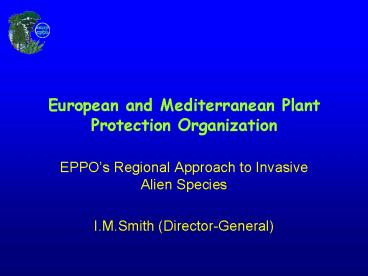European and Mediterranean Plant Protection Organization - PowerPoint PPT Presentation
1 / 14
Title:
European and Mediterranean Plant Protection Organization
Description:
Regional Plant Protection Organization for Europe and Mediterranean region ... also falling in previous category - Ambrosia artemisiifolia, Acroptilon repens ... – PowerPoint PPT presentation
Number of Views:61
Avg rating:3.0/5.0
Title: European and Mediterranean Plant Protection Organization
1
European and Mediterranean Plant Protection
Organization
- EPPOs Regional Approach to Invasive Alien
Species - I.M.Smith (Director-General)
2
EPPO
- Founded 1951
- Regional Plant Protection Organization for Europe
and Mediterranean region - 44 member countries (through National Plant
Protection Organizations) - Secretariat in Paris
- Council, Executive Committee, Working Parties,
Panels
3
EPPO Members
- Member States of European Union
- EU Accession States (2004)
- Probable EU Members in later years
- Russia and other CIS countries
- Mediterranean countries (North Africa, Middle
East)
4
EPPO Regional Standards
- For phytosanitary measures
- PM1 general (4)
- PM2 pest-specific phytosanitary measures (300)
- PM3 phytosanitary procedures (60)
- PM4 certification schemes (30)
- PM5 PRA schemes (5)
- PM6 safety of biological control (3)
- PM7 diagnostic protocols (30)
- PM8 commodity-specific measures (in prep.)
- PM9 national regulatory control systems (in
prep.)
5
EPPO A1 A2 Lists
- EPPO Standard PM 1 / 2 A1 and A2 lists of
recommended quarantine pests - A1 list (not present in EPPO region)
- A2 list (limited distribution in EPPO region)
- Subject to IPPC and WTO disciplines (in
particular, technical justification by PRA) - Managed by national regulations in the framework
of a harmonized regional approach
6
EPPO Council Resolution
- Invasive alien species which have an effect on
plants are quarantine pests under the IPPC - NPPOs should consider their responsibilities for
the management of such species, in cooperation
with the environmental authorities
7
Quarantine pests
- Agricultural (Ralstonia solanacearum on potato
Rhagoletis pomonella on apple) - Forests (Ceratocystis fagacearum on oaks
Bursaphelenchus xylophilus on conifers) - Pests of wild flora (in principle)
- Indirect pests (bee parasites, e.g. Varroa
jacobsoni earthworm predators, e.g.
Arthurdendyus triangulatus) - Plants ..
8
Plants as quarantine pests
- Parasitic plants Arceuthobium spp. (dwarf
mistletoes Striga spp. (witchweeds) already
treated as quarantine pests by some countries - Weeds (of cultivation) treated as quarantine
pests by some EPPO countries, but technical
justification arguable - Invasive plants (in environments other than
cultivated land) not treated as quarantine
pests at the moment (unless also falling in
previous category - Ambrosia artemisiifolia,
Acroptilon repens )
9
EPPO Regional approach
- Treat invasive alien species like quarantine
pests (national measures, regionally harmonized) - Document them and subject them to PRA
individually - Propose measures individually
- Select on basis of risk of introduction and
spread at regional level - Respect CBD guiding principles
- General background measures (e.g. for soil)
- Alert list
10
Origins and pathways
- A1 invasive alien species (not yet in)
- Multiple entry pathways
- Not necessarily invasive at origin
- May be horticultural plants
- Some obvious cases but otherwise difficult to
categorize - A2 invasive alien species (already in)
- Entry pathways not key priority
- Internal pathways mostly natural
- Known to be invasive (sometimes after lag phase)
- Relatively easy to categorize, but difficult to
decide appropriate measures
11
EPPO Regional Standards
- For phytosanitary measures
- PM1 general (4)
- PM2 pest-specific phytosanitary measures (300)
- PM3 phytosanitary procedures (60)
- PM4 certification schemes (30)
- PM5 PRA schemes (5)
- PM6 safety of biological control (3)
- PM7 diagnostic protocols (30)
- PM8 commodity-specific measures (in prep.)
- PM9 national regulatory control systems (in
prep.)
12
EPPO Regional Standards
- For phytosanitary measures
- PM1 general (4)
- PM2 pest-specific phytosanitary measures (300)
- PM3 phytosanitary procedures (60)
- PM5 PRA schemes (5)
- PM7 diagnostic protocols (30)
- PM8 commodity-specific measures (in prep.)
- PM9 national regulatory control systems (in
prep.)
13
EPPO programme
- Involve the NPPOs in invasive alien species
- Risk analysis
- Information
- Measures
- Consultation with environmental authorities
- EPPO activity
- EPPO Panel in Invasive Alien Species
- Documentation of status of individual species in
EPPO region - Adaptation of PRA systems for invasive species
- Recommendation of species requiring management
- International cooperation and participation
(Convention on Biological Diversity, Berne
Convention, CABI Compendium, ..)
14
(No Transcript)































